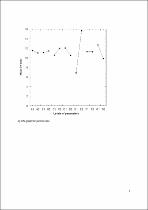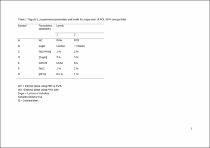 ResearchSpace
ResearchSpace
Design and formulation of nano-sized spray dried efavirenz. Part I: Influence of formulation parameters
JavaScript is disabled for your browser. Some features of this site may not work without it.
- ResearchSpace
- →
- Research Publications/Outputs
- →
- Journal Articles
- →
- View Item
| dc.contributor.author |
Katata, L

|
|
| dc.contributor.author |
Tshweu, L

|
|
| dc.contributor.author |
Naidoo, Saloshnee

|
|
| dc.contributor.author |
Kalombo, Lonji

|
|
| dc.contributor.author |
Swai, H

|
|
| dc.date.accessioned | 2013-01-28T07:53:20Z | |
| dc.date.available | 2013-01-28T07:53:20Z | |
| dc.date.issued | 2012-10 | |
| dc.identifier.citation | Katata, L., Tshweu, L., Naidoo, S., Kalombo, L. and Swai, H. 2012. Design and formulation of nano-sized spray dried efavirenz. Part I: Influence of formulation parameters. Journal of Nanoparticle Research, vol. 14(10), pp. 1247-1254 | en_US |
| dc.identifier.issn | 1388-0764 | |
| dc.identifier.issn | 1572-896X | |
| dc.identifier.uri | http://link.springer.com/article/10.1007%2Fs11051-012-1247-0 | |
| dc.identifier.uri | http://hdl.handle.net/10204/6429 | |
| dc.description | Copyright: 2012 Springer. This is the preprint version of the work. The definitive version is published in Journal of Nanoparticle Research, vol. 14(10), pp. 1247-1254 | en_US |
| dc.description.abstract | Efavirenz (EFV) is one of the first-line antiretroviral drugs recommended by the World Health Organisation for treating HIV. It is a hydrophobic drug that suffers from low aqueous solubility (4 lg/mL), which leads to a limited oral absorption and low bioavailability. In order to improve its oral bioavailability, nano-sized polymeric delivery systems are suggested. Spray dried polycaprolactone-efavirenz (PCL-EFV) nanoparticles were prepared by the double emulsion method. The Taguchi method, a statistical design with an L8 orthogonal array, was implemented to optimise the formulation parameters of PCL-EFV nanoparticles. The types of sugar (lactose or trehalose), surfactant concentration and solvent (dichloromethane and ethyl acetate) were chosen as significant parameters affecting the particle size and polydispersity index (PDI). Small nanoparticles with an average particle size of less than 254 ± 0.95 nm in the case of ethyl acetate as organic solvent were obtained as compared to more than 360 ± 19.96 nm for dichloromethane. In this study, the type of solvent and sugar were the most influencing parameters of the particle size and PDI. Taguchi method proved to be a quick, valuable tool in optimising the particle size and PDI of PCL-EFV nanoparticles. The optimised experimental values for the nanoparticle size and PDI were 217 ± 2.48 nm and 0.093 ± 0.02. | en_US |
| dc.language.iso | en | en_US |
| dc.publisher | Springer | en_US |
| dc.relation.ispartofseries | Workflow;10025 | |
| dc.subject | Spray dried | en_US |
| dc.subject | Polycaprolactone | en_US |
| dc.subject | Efavirenz | en_US |
| dc.subject | Nanoparticles | en_US |
| dc.subject | Taguchi method | en_US |
| dc.title | Design and formulation of nano-sized spray dried efavirenz. Part I: Influence of formulation parameters | en_US |
| dc.type | Article | en_US |
| dc.identifier.apacitation | Katata, L., Tshweu, L., Naidoo, S., Kalombo, L., & Swai, H. (2012). Design and formulation of nano-sized spray dried efavirenz. Part I: Influence of formulation parameters. http://hdl.handle.net/10204/6429 | en_ZA |
| dc.identifier.chicagocitation | Katata, L, L Tshweu, Saloshnee Naidoo, Lonji Kalombo, and H Swai "Design and formulation of nano-sized spray dried efavirenz. Part I: Influence of formulation parameters." (2012) http://hdl.handle.net/10204/6429 | en_ZA |
| dc.identifier.vancouvercitation | Katata L, Tshweu L, Naidoo S, Kalombo L, Swai H. Design and formulation of nano-sized spray dried efavirenz. Part I: Influence of formulation parameters. 2012; http://hdl.handle.net/10204/6429. | en_ZA |
| dc.identifier.ris | TY - Article AU - Katata, L AU - Tshweu, L AU - Naidoo, Saloshnee AU - Kalombo, Lonji AU - Swai, H AB - Efavirenz (EFV) is one of the first-line antiretroviral drugs recommended by the World Health Organisation for treating HIV. It is a hydrophobic drug that suffers from low aqueous solubility (4 lg/mL), which leads to a limited oral absorption and low bioavailability. In order to improve its oral bioavailability, nano-sized polymeric delivery systems are suggested. Spray dried polycaprolactone-efavirenz (PCL-EFV) nanoparticles were prepared by the double emulsion method. The Taguchi method, a statistical design with an L8 orthogonal array, was implemented to optimise the formulation parameters of PCL-EFV nanoparticles. The types of sugar (lactose or trehalose), surfactant concentration and solvent (dichloromethane and ethyl acetate) were chosen as significant parameters affecting the particle size and polydispersity index (PDI). Small nanoparticles with an average particle size of less than 254 ± 0.95 nm in the case of ethyl acetate as organic solvent were obtained as compared to more than 360 ± 19.96 nm for dichloromethane. In this study, the type of solvent and sugar were the most influencing parameters of the particle size and PDI. Taguchi method proved to be a quick, valuable tool in optimising the particle size and PDI of PCL-EFV nanoparticles. The optimised experimental values for the nanoparticle size and PDI were 217 ± 2.48 nm and 0.093 ± 0.02. DA - 2012-10 DB - ResearchSpace DP - CSIR KW - Spray dried KW - Polycaprolactone KW - Efavirenz KW - Nanoparticles KW - Taguchi method LK - https://researchspace.csir.co.za PY - 2012 SM - 1388-0764 SM - 1572-896X T1 - Design and formulation of nano-sized spray dried efavirenz. Part I: Influence of formulation parameters TI - Design and formulation of nano-sized spray dried efavirenz. Part I: Influence of formulation parameters UR - http://hdl.handle.net/10204/6429 ER - | en_ZA |







